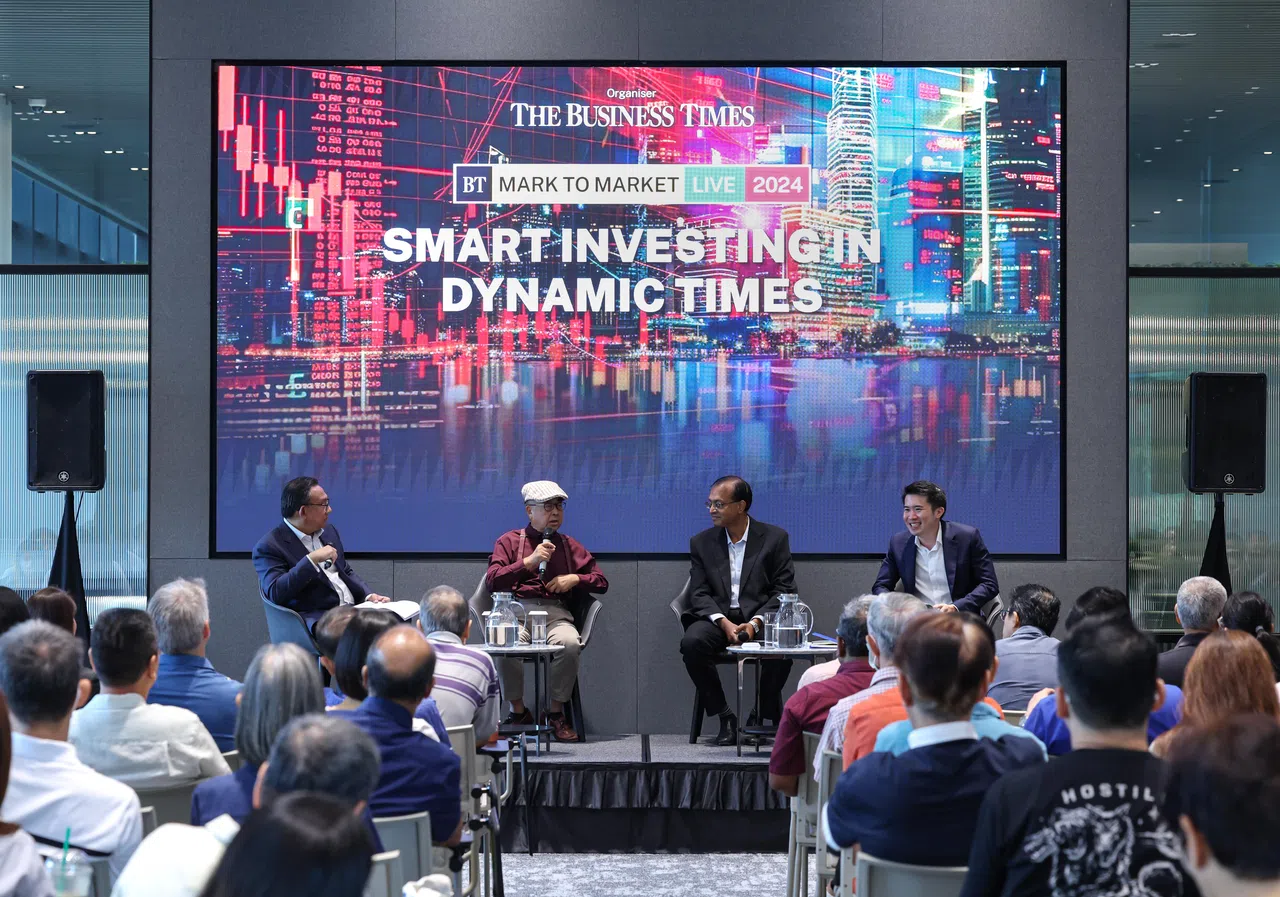INVESTORS should keep an eye out for value-creating corporate restructurings and artificial intelligence (AI) plays, said panellists at The Business Times’ (BT) market outlook forum on Saturday (Jul 13).
The interest rate trajectory will also be crucial to determining cyclical winners and losers, panellists said during the Mark to Market ‘Live’ event moderated by BT senior correspondent Ben Paul.
The panel comprised Song Seng Wun, Singapore economic adviser at CGS International; Krishna Guha, analyst at Maybank Securities; and Gerald Wong, chief executive of investment advisory platform Beansprout.
Song noted that Singapore’s economy has evolved from a developing one that could achieve annual growth rates of 10 per cent or more, into a mature one growing at around 3 per cent.
This has changed the rates of growth that Singapore companies can achieve, and the types of businesses that can thrive.
Property developers, for instance, may find it increasingly difficult to generate the same returns as before, said Guha. Several are therefore restructuring and focusing on investment management, he added.
BT in your inbox
Start and end each day with the latest news stories and analyses delivered straight to your inbox.
Companies will also need to find new avenues of growth, said Wong, and that includes looking outside the city-state.
“What is more important would be to develop global leaders such that we are then able to compete internationally,” Wong said.
He pointed to the merger of Keppel Offshore & Marine and Sembcorp Marine to form Seatrium, and Sats’ acquisition of Worldwide Flight Services, as examples of companies that are beefing up to compete globally.
Sembcorp Marine, a provider of engineering services to the oil and gas industry, last year completed a merger with rival Keppel Offshore & Marine.
More of such significant deals could be on the way, Wong added, making for interesting investment opportunities.
Interest rate cycle
Another major factor affecting the investment landscape is interest rates. This is particularly relevant to Singapore’s stock market, which is heavy on interest rate-sensitive plays such as banks, real estate investment trusts (Reits) and property developers.
While the Reits should benefit from anticipated interest rate cuts, Guha said investors would need to be selective on their choices.
Rates will fall from their currently high levels, but they are unlikely to quickly return to the near-zero levels of recent years. This means some Reits may struggle with higher financing costs and weak property values.
Guha recommended that investors look beyond headline yield figures and focus on total return instead. They should also stick to higher-quality names, he added.
On the outlook for property developers, Wong noted that there have been signs of moderation in property demand.
There has been reduced interest from developers in government land sales, as well as a slowdown in en bloc transactions.
As for Singapore’s three banks, which have lately been on a tear, Wong said their outperformance has been backed by solid fundamentals.
Higher interest rates have boosted net interest margins and allowed all three to report strong returns on equity and pay generous dividends. How they fare will depend on the pace at which interest rates are cut.
Song said he will be keeping an eye on how well the economy holds up after the first cut. If the US labour market stays strong, he said, it may be some time before the Federal Reserve chooses to cut rates again.
He noted that the US economy is in decent health. “There’s still decent growth, job creation is holding up, and unemployment is not rising significantly.”
A key risk, he added, is port congestion and its impact on freight rates. How higher freight rates impact inflation, and how sticky that inflation is, will matter to the interest rate trajectory too.
AI boom
The growing adoption of AI has been one of the strongest drivers of stocks this year. While Singapore does not have large tech companies such as Nvidia, which makes the chips necessary for AI computing, there are other ways to play the AI theme.
This includes looking at companies connected to the increased demand for data centres, including those that supply equipment and services, as they may see the first wave of demand.
While AI presents opportunities, Wong added, it is important to look at the underlying fundamentals of companies.
Nvidia has exceeded analyst expectations in terms of earnings, margins and cash flows, which has helped justify its high valuations to some extent, Wong said. At its market capitalisation of over US$3 trillion, however, its upside potential could be limited.
Competition will also eventually catch up, which could impact the earnings of current market leaders, Wong added. There might, therefore, be better opportunities from a risk-reward perspective.
Is the rapid ascent of the likes of Nvidia a sign of excess? Recalling the dotcom boom, Song said AI is shaping up to be a more concrete trend.
It is “more substance than fluff”, said Song of the AI theme, “although there is still some fluff”. He noted that today’s tech companies boast better technology and infrastructure, and more real-world applications, than their dotcom counterparts.
Where would you put S$1 million?
In rounding off the panel discussion, each panellist was asked how he would invest S$1 million today.
“Diversify”, said Wong. A classic 60/40 split between equities and bonds would be a good place to start, he said, with further diversification within both those asset classes.
Guha said he would stick with real estate, as his forte, but also noted the strong demand for car parks in Singapore’s central business district.
For those approaching or in their retirement years like him, Song said, quality counters that can deliver steady dividends would be the way to go.







